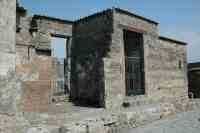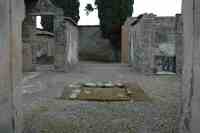
Figure 10: The frontage of the House of the Surgeon (© Damian Robinson, used with permission)
The House of the Surgeon is part of the ancient city of Pompeii and currently survives as an upstanding ruin to a height of up to 4m (Figure 10). It is situated at one of the highest points inside the city walls, 40m from the Porto Ercolano, the Herculaneum Gate, along one of the oldest streets in the city, the Via Consolare (Coarelli 2002, 29). Thanks to the efforts of the AAPP since 2001 in excavating the pre-79 AD levels of the house and their examination of the standing architecture, there is now a plausible preliminary hypothesis for the chronology of the site.

Figure 10: The frontage of the House of the Surgeon (© Damian Robinson, used with permission)

Figure 11: Looking east through the door of the house into the atrium with its impluvium (© Damian Robinson, used with permission)
Its central core is considered to be a classic atrium house, with most rooms opening onto a large room with an impluvium (Figure 11) catching the water draining through a gap in the roof. It was initially built around the start of the 2nd century BC and had a colonnade on both the east and south sides (Figure 12). At this point it looked out over what was probably still a relatively sparsely populated city.

Figure 12: Plan of the earliest phase of the House of the Surgeon, shaded area is roofed (after: Robinson et al. forthcoming)
In the Augustan period the house changed from an outward-looking structure to one that was completely enclosed, the development of the city probably robbing the house of much of its views to the south and east. A garden was added in an attempt to replace these views and the commercial/industrial units at the front (rooms 2, 3 and 4) were created. This phase introduced the main elements of the house as it stood in 79 AD. Its basic structure then changed little until the earthquake of 62 AD, after which it appears to have declined to such an extent that by the time of the eruption of Vesuvius (Figure 13) it resembled a building site in some areas with props supporting the atrium roof and rooms given over to the mixing of plaster, presumably for the renovation of the house (Robinson et al. forthcoming).

Figure 13: Timeline for the House of the Surgeon
Around the time of the earthquake the reception areas of the house were largely decorated in a modestly luxurious fashion with fourth style wall painting in the atrium and surrounding rooms. The service areas of the house are defined by characteristic decoration of white walls with a red socle (Figure 14).

Figure 14: Distinctive service area decoration seen in room 21 (© Damian Robinson, used with permission)
Rooms 2, 3 and 4 were commercial/industrial properties and were created in the Augustan period as part of a reorganisation of the house. These units were not uncommon in Pompeii and were probably still under the ownership of the occupants of the House of the Surgeon and either run by trusted slaves, freedmen or leased out to others of lower social standing. It has been suggested that commercial units with access to the main property were run by part of the household whereas those with no access, but that are still part of the plot as a whole, are more likely to be rented (Ling 1997). Initially both units had upper floors which may have served as living accommodation for those working there, rooms 3 and 4 later having their upper floors accessed by a separate staircase from the street, possibly creating a separate apartment.
The house has been modified since its initial excavation in 1771 by the destructive effects of the weather, the conservation efforts of the site staff and the demands involved with being a modern tourist attraction. The erosion of the wall plaster coupled with the theft of certain decorative elements of plaster in 1792 have resulted in a house consisting mainly of bare walls and doorways. The destruction of most of the evidence for the upper floor by the pyroclastic surges of the 79 AD eruption of Vesuvius combines with the lack of decoration or furnishing to present the modern visitor with an impression of the house that would have seemed very different to that of the pre-79 AD occupant.
© Internet Archaeology/Author(s)
URL: http://intarch.ac.uk/journal/issue23/3/casearch.html
Last updated: Tues Feb 5 2008